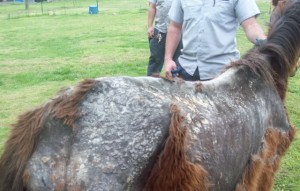 It has been pouring steadily here for a couple of days, and a neighbor told me his rain gauge shows 6 inches so far. I had planned a day of riding, but am going to put that on hold and write a little bit about rain rot. It’s something I’ve only seen once or twice, and thankfully my horses have never had it, and are shed off enough now they probably aren’t in danger of getting it. But here’s the basic information you need to know about this disease:
It has been pouring steadily here for a couple of days, and a neighbor told me his rain gauge shows 6 inches so far. I had planned a day of riding, but am going to put that on hold and write a little bit about rain rot. It’s something I’ve only seen once or twice, and thankfully my horses have never had it, and are shed off enough now they probably aren’t in danger of getting it. But here’s the basic information you need to know about this disease:
Rain rot is sometimes called “rain scald”, and the technical term for the disease is streptothricosis. It usually occurs during spring in very wet conditions when horses have a longer hair coat that traps the moisture for an extended period of time. A fungal organism called dermatophilus congolensis gets into the epidermis through an insect bite, cut, or scrape, and from there does its damage. It will appear in large crusty circles or small raised areas with scabs. A crusty serum can elevate the hair and make bumps all over the horse’s skin. When the scab is removed, the skin may be gray and healing or pink and oozing.
Some horses are immune to rain rot, and some horses are very susceptible and will get it year after year. The organism can be carried by a horse, a brush, a blanket, or a saddle. A thorough cleaning of everything associated with the infected horse will help curb the spread of the fungus. Clorox is a good product to use on brushes, stall, buckets, and everything in contact with the horse.
A horse can get over rain rot as it sheds its hair coat. Getting air to the infected areas and taking of the scabs can help cure it. The best treatment is to bathe the horse in a very lathery soap, making sure to wear rubber gloves to protect yourself. Wash and shampoo, and work the scabs to get the crusty parts off so air can get to the infection. Antiseptic creams, desitin, or triple-antibiotic ointments can help kill the fungus. You can also mix lime and sulphur in water, 1 part lime/sulphur to 8 parts water to avoid blistering the skin. Lime and sulphur can be found in garden stores because it is a fungicide that is used on plants such as roses.
The key is to catch this and treat it before it becomes full blown, as it can really hurt a horse’s health and appearance, as shown in the photo above. And the best way to avoid rain rot is to keep your horses clean and dry. A little rain never hurt anybody, but a lot of rain can be devastating!

